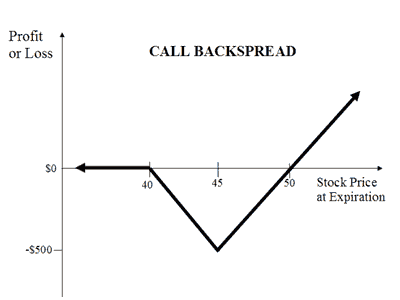BACKSPREAD Strategy for large moves
Post on: 28 Июль, 2015 No Comment

by OptionPundit on January 20, 2007
Strategy for unlimited profit on one side, limited on other.
A backspread is the sale of an option(s) and the purchase of a greater number of the same type of options that are out-of-the-money with respect to the one(s) purchased. For example, an 80/90 put 1-by-3 backspread is long 3*80 puts and short 1*90 put. The Opposite for this trade is called Ratio spread.
There are several ways to play big moves caused by special events such as Earnings, FDA approval etc. Most common option trading strategies are:
- Simply buy a call or put option
- Play either bull put, bull call or bear put bear call spreads
- Or maybe even a straddle or strangle if one isnt sure which direction it was going to make the big move.
Each strategy has its own merits and demerit and one can choose any depending upon his or her trading style. Over a period of time, I have noticed though that I (maybe others too) end up not predicting the direction very well. There are so many factors that play key role in determining the short term movement of the stock after the announcement. For instance, earnings beat estimate, revenue beat estimates but the outlook is lowered or several combination of these three and many more.
In search of excellence and continuous improvement I tried to learn more and more about it and it was when I came across Dan Sheriden’s free seminar at CBOE…backspread..that has potential to make money in either direction and it wont cost a nickel to put on the trade as you can always do it for credit….Its called backspread buy x times as many as you will sell.
Since you will take home more premium than you shell out; hence, you will receive a credit at the beginning of the trade. However, you have to make sure that you meet the margin requirement, if needed. Now, everything sounds good, you make money in either direction…so what’s the catch? The downside to the backspread is that the stock MUST make the big move you anticipated, or else the position will lose money. At the same time implied volatility (IV) also plays an important role. Typically, IV before the announcement is very high (so is the premium), and after the announcement IV will be crushed and back to normal. Hence, you need to do a thorough risk/reward analysis. The profit potential is unlimited, and if your market direction is completely wrong, you can still walk away unscathed.
Lets take Apple’s example that I played (details are here ). I was bullish on AAPL and expected a significant up-move after the earning announcement on Jan 18 th. 2007. Instead of buying straight call, I opened a trade in the form of a call backspread. A typical backspread is usually done in a 1 x 2 fashion. In other words, buy twice as many options than you sell but you can always choose your own ratio. In this example, I sold 3 AAPL January 2007 $95 calls for $3.25 and bought 7 AAPL January 2007 100 calls for $1.18. This gave me a credit of $1.65 per backspread. The margins requirement was about $1365 per backspread. After placing this on 17 th. I waited for announcement that was on 17 th after market close.
My break-even point, or where we start to make money on our spread, is somewhere between $95.5 and $103.4, as seen in the My AAPL Play for tonight ” post. Since I was bullish, this type of trade could work extremely well if my prediction is right. One great thing about the backspread is that if I was completely wrong about my prediction and AAPL tanks (as happened) below $95.5, I shall still make money by keeping my initial credit. My danger zone however is in between $95.5 and $103.4.
If you look at the r/R graph, youll see that my maximum potential was at $100 mark. So, in order to use proper money management, we want to be out of the trade as soon as possible if it is around $100.
Rest you may read on both posts. The backspread is a great trade if youve got a real good feeling of a large directional move. You get to initiate the trade for a credit, and relax. However, if you want to maximize the chances of maximum returns, a deep analysis is important to understand where it might go. Even if youre completely wrong in your directional assessment, you may still make money. But it MUST move. That’s the key.
When I get time, I shall post on how to select stocks that are poised for big move.














